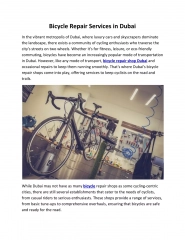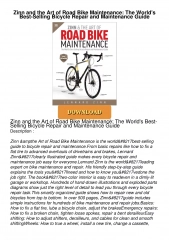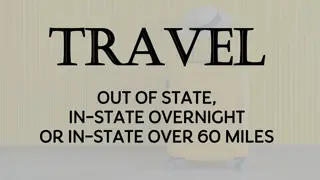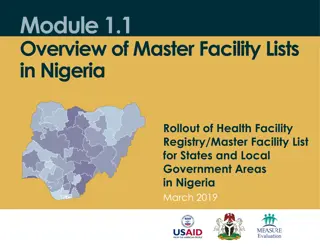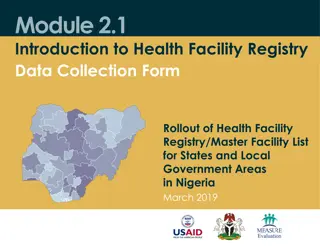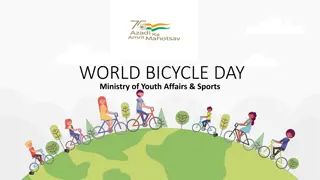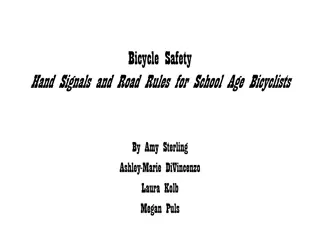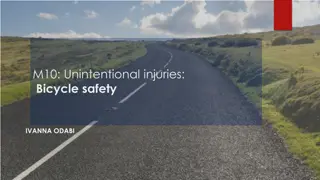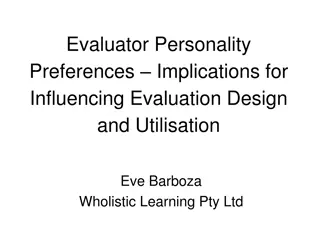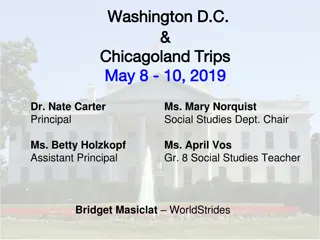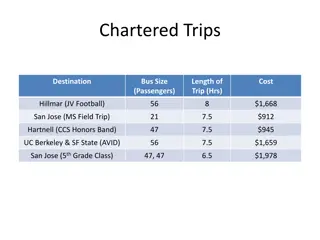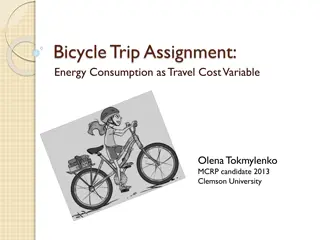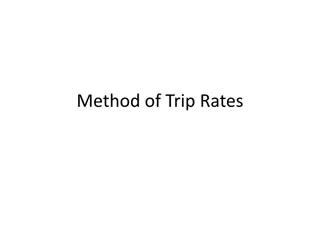Understanding Bicyclist Facility Preferences for Increasing Bicycle Trips
This research study aims to investigate the various preferences and effects of different bicycle facilities on increasing bicycle trips. It explores how individual preferences for bike facilities differ and the effectiveness of these facilities in attracting new trips. The study delves into the impacts of different types of facilities on cycling rates and changes in perceptions. By using a quasi-experimental design, the research compares changes between test and control groups to provide valuable insights for promoting cycling.
Download Presentation

Please find below an Image/Link to download the presentation.
The content on the website is provided AS IS for your information and personal use only. It may not be sold, licensed, or shared on other websites without obtaining consent from the author. Download presentation by click this link. If you encounter any issues during the download, it is possible that the publisher has removed the file from their server.
E N D
Presentation Transcript
NCHRP 08-102: Bicyclist Facility Preferences and Effects on Increasing Bicycle Trips Dr. Kari Watkins, Calvin Clark, Dr. Pat Mokhtarian, Dr. Giovanni Circella Georgia Institute of Technology Dr. Susan Handy and Alison Kendall Independent Consultants
Outline Introduction Methodology Description Focus Group Findings Description of Survey Respondents Wave 1 Results and Discussion Wave 2 Results and Discussion Difference-in-Difference Results and Discussion Conclusions 2
Study Objectives The purpose of this research is to broaden the understanding of bike facility preferences among current and potential cyclists How do bicycle facility preferences vary among individuals? How effective are various bicycle facilities in attracting new trips? 4
Past Work Handy et al. (2014) explain that many studies do not differentiate between types of infrastructure Many have tried to measure differences (Buehler and Pucher 2012; Hankey et al. 2012; Krizek and Johnson 2006; etc.) Results have been very mixed Dill and McNeil (2013) suggest that different types of facilities have differing impacts between rider types Current understanding of differences is underdeveloped 5
Research Questions What types of facilities are preferred? How can we explain variations in preferences? How do different facilities affect cycling trips? What impacts an individual s propensity to try a new facility? What are the aggregate changes in cycling rates that accompany new facilities? How do changes in perceptions correspond? 6
Research Design Quasi-experimental (difference-in-difference) design The purpose is to compare individual changes of those in a test group to those in a control group Test O1T Control O1C First Wave ? Treatment O2T O1T = O2C O1C O2T O2C Second Wave O = Observation 8
Data Sources Interviews and focus groups (Clifton and Handy 2003; Handy et al. 2014) Pre-existing sources such as Census (Krizek et al. 2009b and many others) Restricts analysis to cross-sections Surveys are preferred source Intercept surveys (Thakuriah et al. 2012; Mitra et al. 2016) Mail/online surveys (Xing and Handy 2014; Forsyth et al. 2010; etc.) 9
Individual Factors Gender (Krizek and Johnson 2006; Akar and Clifton 2010; Handy et al. 2010; etc.) Females are less likely Age (Hankey et al. 2012; Xing et al. 2010; Stinson et al. 2014; etc.) Mixed results Education and Employment (Krizek and Johnson 2006; Moudon et al. 2005; etc.) Generally increases likelihood of biking Vehicle ownership (Buehler and Pucher 2012; Dill and Carr 2003; etc.) Mixed results Bike ownership (Moudon et al. 2005; Cervero and Duncan 2003; etc.) Enables biking Race/Ethnicity (Parkin et al. 2008; Hankey et al. 2012; Parker et al. 2013) Mixed results Attitudes (Fernandez et al. 2014; Emond et al 2009) 10
Literature Review Summary Differences in perceptions of cycling can vary between individuals and from place to place It is hard to generalize conclusions from location to location and from individual to individual This research explores these differences in regards to perceptions of cycling facilities 11
Selection of Communities Tennessee Anniston Opelika Alabama Georgia 12
Selection of Communities Tennessee Chattanooga Anniston Opelika Alabama Georgia 13
Selection of Communities Control Treatment Small Suburban Tennessee Northport Opelika Chattanooga % Under $50,000 63% 59% % Under 50 Years 58% 52% % White / Caucasian 56% 45% Anniston Northport Opelika Survey 1: Fall 2016 Opelika two-way bike lane, Opened 2017 Survey 2: Spring 2018 Alabama Georgia 14
Selection of Communities Control Treatment Rural Tennessee Talladega Anniston Chattanooga % Under $50,000 74% 73% % Under 50 Years 57% 50% % White / Caucasian 40% 36% Anniston Talladega Northport Opelika Survey 1: Fall 2016 Anniston sharrows, Opened Late 2016 Survey 2: Spring 2018 Alabama Georgia 15
Selection of Communities Control Treatment Small Urban Tennessee Birmingham Chattanooga Chattanooga % Under $50,000 72% 75% % Under 50 Years 71% 67% % White / Caucasian 41% 43% Anniston Birmingham Birmingham Talladega Northport Opelika Survey 1: Fall 2016 Chattanooga bike lanes, Opened 2018 Survey 2: Fall 2018 Alabama Georgia 16
Focus Group Methodology Focus groups were held in each of the treatment communities Current and potential cyclists Participants were shown images of potential bicycle facilities and asked about perceptions 17
First Wave Survey Methodology The survey was 12 pages, taking ~30 minutes to complete A. Attitudes B. Technology usage C. Household location D. Daily travel E. Bicycling experience F. Demographics 18
Infrastructure Images Images were prepared to simulate different environments Two Lane Four Lanes Parking No Parking Parking No Parking Sharrow Bike Lane Buffered Bike Lane Protected Bike Lane 19
Infrastructure Images V1 V2 V3 V4 V1 V2 V3 V4 Sharrow Bike Lane Buffered Bike Lane Protected Bike Lane 21
Second-wave Survey Methodology The survey was 8 pages, taking ~20 minutes to complete A. Attitudes B. Daily travel C. Bicycling experience D. Demographics Questions remained the same from the previous survey, with some questions removed for brevity Two new questions were added 22
Second-wave Survey Description 11. We would like to know whether transportation in your community has changed since Fall 2016, either for better or worse. Please give your opinion for each category below. Neutral/ No change Much worse Somewhat worse Somewhat better Much better Traffic congestion Parking availability Public transit route coverage (can reach more/fewer places) Public transit frequency (comes more/less often) Sidewalk availability (more/fewer of them) Sidewalk quality Bicycle safety Availability of bicycle lanes and trails Quality of bicycle lanes and trails Availability of taxi/ Uber/ Lyft Other (please specify): _________________________ 23
Second-wave Survey Description Have you seen this added in your community? Not sure If you ve seen it have you used it? do you like it? Not sure No Yes No Yes No Neutral Yes Sharrow Bike Lane Buffered Bike Lane Protected Bike Lane Multi-use Path 24
Perceptions of Different Facilities Uncomfortable with sharrows Clear preference for separation from cars Physical protection was most preferred On-street parking was perceived as a negative for bicycling Some perceived the number of automobile lanes as negative; others did not mind or even liked having more space for cars to pass Many liked multi-use paths, though were held back by the difficulties of mixing bicyclist and pedestrian traffic 26
Other Concerns Concerns stem from mistrust of drivers Many viewed drivers in their communities as more aggressive than in other communities Many would rather wait for more people to start biking before they would join 27
First Wave Response Addresses were purchased from Direct Mail Printed surveys were mailed to all addresses in each area Respondents were given the option to take an online version of the survey Area Households Invited Responses Response Rate 4.6% 5.5% 5.4% 2.8% 6.3% 6.4% 5.2% Treatment / Control Treatment Treatment Treatment Control Control Control Anniston Opelika Chattanooga Talladega Northport Birmingham Total 4,348 3,363 4,400 3,305 3,707 4,294 23,418 198 185 239 93 234 274 1223 29
Data Cleaning Section A (Attitudes): Cases with >5 missing items (out of 38 in the section) were deleted Missing items were imputed Section E (Bicycle experience): Responses missing dependent variables were excluded from the respective models Section F (Demographics): Responses with small amounts of missing sociodemographic data were supplemented with information from targeted marketing database After cleaning, 1,178 responses remained, with up to 7,068 image responses for each of 4 questions 30
Second-wave Survey Response Printed surveys were mailed to all respondents of first survey A URL was included to access the online version of the survey Households Invited 4348 3363 4400 3305 3708 4294 23,418 First Wave Responses 198 185 239 93 234 274 1223 First Wave Response Rate 4.6% 5.5% 5.4% 2.8% 6.3% 6.4% 5.2% Second Wave Responses 98 103 85 47 145 105 583 Second Wave Response Rate 49% 56% 36% 51% 62% 38% 53% Area Anniston* Opelika* Chattanooga* Talladega Northport Birmingham Total *Indicates treatment location 31
Perceptions Analysis How is bicycling on different roadways perceived based on certain factors? Type of bike facility Number of automobile lanes Presence/absence of on-street parking How do these perceptions differ based on cycling frequency/ability? Recreation Utilitarian Unable to bike 33
User Preference Analysis Safety Comfort Willingness to Try *Note that axes do not start at 0 34
Regression Models Dependent Variables: Likert Type from 1 to 5 Variable Comfort Safety Willingness to Try Coefficient 2.82 *** Coefficient 2.90 P Coefficient 2.62 P P Constant *** <0.001 *** <0.001 <0.001 Bicycle Infrastructure Types Bike Lane (BL) Buffered BL (BBL) One-way Protected Two-way Protected Multi-use Roadway Characteristics Parking Four Lanes Framing Effects BL-No Parking BBL-No Parking BL-Two Lanes # of Responses R2 *Significant at P = 0.050 or better **Significant at P = 0.010 or better ***Significant at P < 0.001 0.37 0.73 1.34 1.16 1.24 *** *** *** *** *** <0.001 <0.001 <0.001 <0.001 <0.001 0.45 0.89 1.68 1.45 1.53 *** *** *** *** *** <0.001 <0.001 <0.001 <0.001 <0.001 0.30 0.57 1.12 0.96 1.12 *** *** *** *** *** <0.001 <0.001 <0.001 <0.001 <0.001 -0.27 0.02 *** <0.001 0.477 -0.26 0.05 *** <0.001 0.103 -0.17 -0.02 *** <0.001 0.500 0.42 0.22 0.28 *** *** *** 6743 0.175 <0.001 <0.001 <0.001 0.50 0.33 0.35 *** *** *** 6723 0.232 <0.001 <0.001 <0.001 0.41 0.22 0.22 *** ** * 6664 0.093 <0.001 0.002 0.015 35
Regression Models (with Demographics) Variable Comfort Safety Willingness to Try Coefficient 3.59 Coefficient P Coefficient 2.55 P P Constant 3.09 *** <0.001 *** <0.001 *** <0.001 Bicycle Infrastructure Types Bike Lane Buffered Bike Lane 0.77 One-way Protected Two-way Protected Multi-use Roadway Characteristics Parking Four Lanes Framing Effects BL-No Parking BBL-No Parking BL-Two Lanes Sociodemographics Age Education Vehicles Per Driver Driver s License Child in Home Female African-American # of Responses R2 0.40 *** *** *** *** *** <0.001 <0.001 <0.001 <0.001 <0.001 0.47 0.90 1.69 1.47 1.55 *** *** *** *** *** <0.001 <0.001 <0.001 <0.001 <0.001 0.32 0.59 1.15 1.03 1.19 *** <0.001 *** <0.001 *** <0.001 *** <0.001 *** <0.001 1.39 1.21 1.30 -0.27 0.03 *** <0.001 0.477 -0.25 0.04 *** <0.001 0.103 -0.16 -0.03 *** <0.001 0.441 0.41 0.23 0.26 *** *** *** <0.001 <0.001 <0.001 0.50 0.34 0.31 *** *** *** <0.001 <0.001 <0.001 0.44 0.26 0.19 *** <0.001 *** <0.001 * 0.038 -0.004 0.04 -0.16 *** *** ** <0.001 <0.001 0.003 -0.004 0.03 *** ** <0.001 0.001 -0.01 0.09 -0.38 *** <0.001 *** <0.001 *** <0.001 0.18 -0.08 *** * <0.001 0.033 -0.29 -0.08 *** <0.001 * 0.047 6086 0.153 6159 0.201 6529 0.248 36
Regression Models (with Attitudes) Variable Comfort Coefficient Constant 2.89 *** Bicycle Infrastructure Types Bike Lane 0.36 *** Buffered Bike Lane 0.74 *** One-way Protected 1.35 *** Two-way Protected 1.16 *** Multi-use 1.23 *** Roadway Characteristics Parking -0.26 *** Four Lanes -0.007 Framing Effects BL-No Parking 0.44 *** BBL-No Parking 0.20 *** BL-Two Lanes 0.28 *** Sociodemographics Age (in 10s of years) Education Driver s License Child in Home Female African-American Attitudes A18. Stubborn -0.053 *** A24. Cyclists unsafe -0.087 *** A28. Cyclists poor -0.030 * Car Dependence -0.033 * Bike Enjoyment 0.20 *** Active Travel 0.11 *** Utilitarian Travel -0.058 *** Risk Taking 0.051 *** Travel Time Usefulness Anti-Exercise # of Responses 6762 R2 0.246 Adj R2 0.244 .P < 0.1, *P < 0.05, **P < 0.01, ***P < 0.001 Safety Willingness to Try Coefficient 3.03 *** 0.30 *** 0.60 *** 1.14 *** 0.96 *** 1.14 *** -0.17 *** -0.07 * 0.43 *** 0.18 ** 0.20 * -0.036 *** 0.029 ** -0.21 *** -0.13 *** P Coefficient 2.43 *** 0.46 *** 0.91 *** 1.71 *** 1.47 *** 1.54 *** -0.25 *** 0.02 0.50 *** 0.32 *** 0.30 *** 0.18 *** -0.082 * P P <0.001 <0.001 <0.001 <0.001 <0.001 <0.001 <0.001 <0.001 <0.001 <0.001 <0.001 <0.001 <0.001 <0.001 <0.001 <0.001 <0.001 <0.001 <0.001 0.477 <0.001 0.566 <0.001 0.024 <0.001 <0.001 <0.001 <0.001 <0.001 <0.001 <0.001 0.002 0.012 <0.001 0.004 <0.001 0.020 <0.001 <0.001 <0.001 <0.001 0.036 0.013 <0.001 <0.001 <0.001 <0.001 -0.036 -0.11 *** -0.055 *** 0.14 *** 0.090 *** -0.039 0.043 ** 0.009 <0.001 -0.033 * -0.15 *** -0.31 * -0.14 *** 0.47 *** 0.11 *** 0.069 *** -0.071 *** -0.069 *** 0.025 <0.001 0.037 <0.001 <0.001 <0.001 <0.001 <0.001 <0.001 0.008 0.002 ** ** 6578 0.290 0.288 <0.001 <0.001 <0.001 6557 0.335 0.332 37
Rider Segmentations Respondents were split into one of four different rider classes: 1. Potential cyclist (N=700) zero miles of biking per month, but able to ride a bike, regardless of confidence level. 2. Recreational cyclist (N=166) non-zero bike distance per month, but do not bike more than once a month for utilitarian purposes, or bike less than a mile a week. 3. Utilitarian cyclist (N=84) bike more than once a month for utilitarian purposes and bike at least a mile a week, on average. 4. Cannot bike (N=163) those who state that they cannot ride a bicycle. 38
Segmented Models (Main Effects) Variable Comfort Main Effects Coefficient Constant 3.14 *** Recreation (2) 0.17 *** Utilitarian (3) -0.54 * Unable (4) -0.09 * Bicycle Infrastructure Types Bike Lane (BL) 0.40 Buffered BL (BB) 0.76 One-way Protected 1.39 Two-way Protected 1.22 Multi-use 1.30 Roadway Characteristics Parking -0.29 Four Lanes 0.02 Framing Effects BL-No Parking 0.41 BB-No Parking 0.24 BL- Two Lanes 0.24 Sociodemographics Age -0.003 Education 0.03 Vehicles per Driver -0.23 Child in Home Driver s License Female African American Safety Willingness to Try Coefficient 3.74 *** -0.65 -0.20 -1.89 *** P Coefficient 2.64 0.15 -0.86 -0.01 P P <0.001 <0.001 0.012 0.031 *** *** *** <0.001 <0.001 <0.001 0.858 <0.001 0.004 0.428 <0.001 ** *** *** *** *** *** <0.001 <0.001 <0.001 <0.001 <0.001 0.47 0.90 1.72 1.50 1.56 *** *** *** *** *** <0.001 <0.001 <0.001 <0.001 <0.001 0.32 0.59 1.15 1.02 1.19 *** *** *** *** *** <0.001 <0.001 <0.001 <0.001 <0.001 *** <0.001 0.438 -0.28 0.05 *** <0.001 0.099 -0.21 -0.05 *** <0.001 0.152 *** *** ** <0.001 <0.001 0.001 0.51 0.36 0.29 *** *** *** <0.001 <0.001 <0.001 0.44 0.25 0.18 *** *** * <0.001 <0.001 0.043 *** ** *** <0.001 -0.004 0.002 <0.001 *** * ** <0.001 0.032 0.007 0.236 0.015 -0.009 0.03 -0.48 *** * *** <0.001 0.012 <0.001 0.02 -0.17 -0.05 0.22 * -0.19 -0.16 *** *** <0.001 <0.001 39
Segmented Models (Incremental) Variable Comfort Safety Willingness to Try Coefficient Coefficient P Coefficient P P Incremental Effects Utilitarian Segment (3)*BL (3)*BB (3)*One-way Protected (3)*Two-way Protected (3)*Multi-use (3)*Parking (3)*Age (3)*Vehicles/Driver (3)*Child in Home Cannot Bike Segment (4)*Child in Home (4)*Parking (4)*Four Lanes (4)*Age (4)*African American (4)*Vehicles/Driver Recreation Segment (2)*Age (2)*Education # of Responses R2 Adj R2 0.31 0.36 0.44 0.40 0.59 0.29 0.006 0.44 -0.27 * * * 0.041 0.026 0.030 0.072 0.002 0.009 0.095 0.014 0.036 ** ** 0.20 0.009 0.44 * ** ** 0.046 0.008 0.010 0.009 0.50 * * 0.032 0.016 * * -0.25 0.082 0.37 0.24 0.009 0.62 0.40 *** * * *** * <0.001 0.014 0.015 <0.001 0.026 0.008 0.15 ** *** 5966 0.206 0.203 0.009 <0.001 6038 0.212 0.210 5982 0.268 0.265 40
General Perceptions of Change Bike Safety Bike Lane / Trail Availability Bike Lane / Trail Quality *denotes treatment 42
Recognition of New Bike Facilities *** Have you seen it? * * *** *** * * * * ** * * * pre-existing or nearby, ** modified version implemented in study area, *** implemented in study area * * * 43
Recognition of New Bike Facilities *** If so have you used it? * * *** *** * * * * ** * * * pre-existing or nearby, ** modified version implemented in study area, *** implemented in study area * * * 44
Recognition of New Bike Facilities *** do you like it? * * *** *** * * * * ** * * * pre-existing or nearby, ** modified version implemented in study area, *** implemented in study area * * * 45
Changes in User Preferences Variable Comfort (Wave 2) Safety (Wave 2) Willingness to Try (Wave 2) Coefficient 1.33 *** 0.58 *** 0.003 2,468 0.349 0.348 Coefficient 1.58 0.53 0.10 2,516 0.267 0.266 P <0.001 <0.001 0.011 Coefficient 1.53 0.53 0.083 2,507 0.301 0.300 P <0.001 <0.001 0.040 P <0.001 <0.001 0.941 Constant Wave 1 Treatment Responses R2 Adjusted R2 .P < 0.1, *P < 0.05, **P < 0.01, ***P < 0.001 *** *** * *** *** * 47
Changes in User Preferences Variable Comfort (Wave 2) Safety (Wave 2) Willingness to Try (Wave 2) Coefficient 1.33 *** 0.55 *** 0.009 Coefficient 1.70 0.40 0.082 P <0.001 <0.001 0.038 Coefficient 1.62 0.41 0.069 P <0.001 <0.001 0.084 P <0.001 <0.001 0.841 Constant Wave 1 Treatment Bicycle Facility Type Bike Lane Buffered Bike Lane One-way Protected Two-way Protected Multi-use Roadway Characteristics Parking Four Lanes Framing Effects BL-No Parking BB-No Parking BL-Two Lanes Responses R2 Adjusted R2 .P < 0.1, *P < 0.05, **P < 0.01, ***P < 0.001 *** *** * *** *** . 0.31 0.53 1.02 0.74 0.78 *** *** *** *** *** <0.001 <0.001 <0.001 <0.001 <0.001 0.30 0.53 0.98 0.74 0.78 *** *** *** *** *** <0.001 <0.001 <0.001 <0.001 <0.001 0.11 0.23 0.57 0.44 0.43 *** *** *** *** 0.149 <0.001 <0.001 <0.001 <0.001 -0.27 -0.04 *** <0.001 0.362 -0.22 -0.02 *** <0.001 0.733 -0.24 0.06 *** <0.001 0.245 0.13 0.14 -0.05 2,516 0.356 0.353 . 0.234 0.090 0.698 0.21 0.14 -0.09 2,507 0.384 0.381 . . 0.063 0.092 0.471 0.005 0.03 0.08 2,468 0.379 0.376 0.971 0.751 0.519 48
Changes in Bicycling Frequency First Wave Bike Commute Frequency Treatments (N=70) Controls (N=85) Decreased No change Increased Decreased No change Increased Never NA 1 0 0 2 0 3 58 0 1 1 0 0 60 5 1 0 0 1 NA 3 3 1 0 0 7 69 3 0 0 0 0 72 6 0 0 0 0 <1 day a month 1 3 days a month 1 2 days a week 3 4 days a week 5 days a week Total NA 7 NA 6 First Wave Bike Other Trip Frequency Treatments (N=181) Controls (N=181) Decreased No change Increased Decreased No change Increased Never NA 8 1 1 0 3 13 142 5 4 2 1 0 154 8 4 0 2 0 NA 8 2 4 3 0 17 138 7 3 1 1 0 150 11 2 1 0 0 NA 14 <1 day a month 1 3 days a month 1 2 days a week 3 4 days a week 5 days a week Total NA 14 49
Conclusions This project made major contributions by using a quasi-experimental design to assess the impact of bicycle facilities in places where cycling is limited. Both current and potential cyclists prefer separated facilities. Parking was a clear deterrent for all measures of preference, while the effects of the number of traffic lanes were mixed. Facility treatments were associated with perceptions of improved measures of bikeability. Even after the treatments, the number of bicyclists was still small, though there is anecdotal evidence of a small number adopting cycling. Likely a result of the minimal impact of projects in expanding bicycle networks 50


